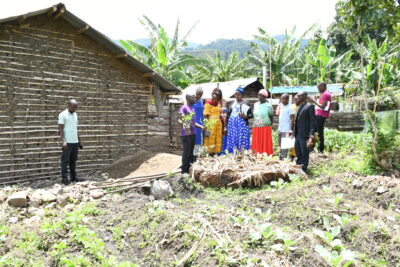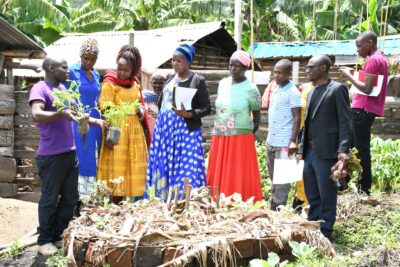How empowered mothers in Fort Portal City, Kabarole district are using Kitchen gardening initiatives in homes to combat malnutrition.
BY: BETTY MUJUNGU
An increasing number of households in Fort Portal City and Kabarole district are embracing the concept of kitchen gardening to combat the prevalent issue of malnutrition, which has become a significant burden for many families.
Responding to the concern raised by health experts and leaders in the Tooro region regarding the high prevalence of malnutrition among children under the age of 5, most households are now actively involved in planting a variety of food crops, with a particular emphasis on vegetables.
The goal is to enhance nutrition and mitigate the burden of malnutrition in the community.


Data from the Uganda Demographic and Health Survey highlights the alarming statistics related to poor feeding practices, revealing that 40.6 percent of children below 5 years are stunted, 2.4 percent suffer from wasting, and 10.3 percent are born with a low birth weight below 2.5kg.
Additionally, anemia affects 45 percent of children below 5 years and 29.4 percent of women of reproductive age.
To address this malnutrition crisis, nutritionists are recommending the cultivation of vegetables. These crops are rich sources of essential minerals such as calcium and iron, as well as vitamins, especially vitamins A and C, which are crucial for children’s growth.
In Fort Portal City, particularly in some villages in North Division, and other sub-counties in the Kabarole district, women in different households have been at the forefront of establishing kitchen gardens in the backyards of their compounds for the past two years.
These gardens feature a diverse range of crops, including Sukuma wiki, eggplants, cabbages, peas, groundnuts, tomatoes, onions, and various other vegetables, aiming to broaden the variety of foods available for family diets.
Ms Ester Kamalha, a resident of Busoma B village in North Division, Fort Portal City, and the chairman of Busoma Young Mothers identified the escalating cases of malnutrition and took the initiative to address the issue.
She said she mobilized mothers from different villages to establish kitchen gardens in their homes.
Ms Kamalha explained that they initiated the effort by creating demonstration gardens at the parish level, providing practical examples for others to learn from.
She said this approach has resulted in a positive ripple effect on other families in the community.
“In 2022, after witnessing numerous cases of malnutrition, we formed a group of Busoma young mothers’ organic farmers dedicated to tackling malnutrition and hidden hunger in our homes. Subsequently, we established a partnership with the Thrive for Good organization from Kenya, which played a pivotal role in providing us with training in nutrition excellence,” She said.
Through the collaboration with Thrive for Good organization, these initiatives not only empower women and mothers in combating malnutrition but also contribute to creating sustainable solutions for addressing nutritional challenges in the region.
She said a total of 50 farmers who are mothers have received training in making kitchen gardens and have been instrumental in assisting other mothers from other households in establishing kitchen gardens to combat malnutrition.
“Many mothers no longer need to rely solely on markets where they go to buy vegetables for their families because the households that have been trained now know how to set up such gardens, they have gardens in their compounds, enabling them to have better control over their diets,”
She said the Thrive for Good organization has supported families with seedlings and established community seedbed gardens to ensure that everyone has access to resources needed for kitchen gardening,” She said.
In some families, women with small pieces of land ingeniously repurpose old empty jerrycans, cutting them to create improvised containers. These containers are then filled with soil, providing a space where they can plant their seeds.
Additionally, some households utilize sacks and polythene bags for this purpose, filling them with soil and planting seeds.
Kitchen gardens are now an integral part of households’ subsistence, reducing food expenses and increasing dietary variety.
To date, mothers from some families shared that after embracing kitchen gardens, their children have been able to eat a balanced diet and their children no longer get malnourished and are optimistic that shortly they will start selling surplus produce, providing an additional source of income.
Ms Moreen Biira, from Kyakora village in North Division, Fort Portal City, shared her transformative experience with kitchen gardening, emphasizing its positive impact on both her family’s finances and their overall diet.
She recounted that, previously, she would request money from her husband every evening to purchase vegetables for the family’s meals. However, there were times when her husband couldn’t provide the funds, resulting in meals without vegetables.
Ms Biira expressed the challenges she faced, narrating an emotional moment when two of her children were admitted to Fort Portal Regional Referral Hospital due to malnutrition doctors informed her that the children were not consuming a balanced diet, and upon returning home, she took immediate action.
Motivated by the need for a diverse and nutritious diet, Ms Biira established a kitchen garden, ensuring it had a variety of foods recommended by the hospital.
“It was painful when I reached the hospital, and they told me that my children were not eating a balanced diet. When I inquired, they told me that the food was at my home. When I returned home, I immediately established a kitchen garden because it had all the variety of food they told me that they needed. I am happy now to report that malnutrition is a history in my family,” She said.
She emphasized that these gardens have changed people’s perceptions that traditionally they were meant to have vegetables for only husbands and that belief has been changed. It’s now the family that is benefiting in addressing malnutrition.
“I am delighted that our families have embraced farming practices and successfully integrated vegetables and greens into our diets. In the past, there were misconceptions that these choices were exclusive to less fortunate families. However, we now acknowledge the positive impact they have had on our eating habits,” He said.
Mr Rauben Kikora Iswanga, a community facilitator and a trainer on the establishment of kitchen gardening, highlighted that community sensitization on kitchen gardening, hygiene, health-seeking behavior, and proper cooking practices to eradicate malnutrition are helping many households.
“Some families have begun to generate income from kitchen gardens, transforming people’s compounds from empty spaces to lush with vegetables. In many villages, there are numerous demonstration gardens, and several families have received support in the form of hoes and watering cans to help them maintain their gardens,” he explained.
He said some families support their work of continuing to establish such gardens, through different donors, they have given some families watering cans, and hoes and said the new plan is to look for funds to acquire a manual irrigation kit worth Shs 2.25 million because in dry spell the garden is dry.
Mr Banard Bwambale, a nutritionist from Fort Portal City, emphasized the importance of not just having kitchen gardens but also proper food handling practices saying that besides kitchen gardens, parents should prioritize feeding their children properly and ensuring pregnant mothers receive adequate nutrition.
“The challenge we have been having is that after harvesting, people take their food to markets for sale and leave little in their homes for children to feed on, and that is why most families have been dealing with the problem of malnutrition,” He said.
He added “We now want people who have food to also learn good cooking habits and proper food preservation methods. Some people dry food in unsanitary conditions, which is dangerous to their health. Others cook food in harmful materials like polythene bags, leading to health complications,” Mr Bwambale said.
He added that all those owning kitchen gardens, need to seek knowledge about the safe use of chemicals such as pesticides, practice agroecology farming practices, and handle food properly to address malnutrition comprehensively.
The 2022 report on nutrition from Fort Portal Regional Referral Hospital, a facility that serves Tooro region revealed that among children aged 0-59 months in Tooro Region, standing at a distressing 86.3 percent for those admitted into outpatient and inpatient therapeutic care.
Additionally, the percentage of pregnant women in the region receiving at least 30 tablets of Folic Acid during their first antenatal care (ANC) visit from July to December 2022 was reported at 74.9 percent.
The nutrition unit at Fort Portal Regional Referral Hospital, which was built to admit 16 patients, is consistently overwhelmed, admitting an average of over 70 children each month coming from different districts of Tooro and Rwenzori region.
Mr Aggrey Gweita, the head of the Nutrition Department at Fort Portal Regional Referral Hospital, said “The facility is supposed to admit 16 patients but we end up admitting at time 25, for a child to become stable it takes about 2 weeks. We need more staff to attend to patients but we thank UNICEF for giving some medicine to give to children even when we discharge them,” Mr Gweita said.
Dr. Samalie Namukose, the Assistant Commissioner of Health Services in charge of Nutrition at the Ministry of Health, last year while in Fort Portal City meeting stakeholders on malnutrition, said the significant burden of malnutrition in the country, necessitates the involvement of all stakeholders in the Tooro sub-region to combat the crisis effectively.
She said at the national level, 25 percent of children below the age of 5 years are stunted while for Tooro region is at 42 percent, signifying a dire situation for child nutrition.
She urged parents to bring their children to health facilities for specialized care at the earliest sign of malnutrition, emphasizing that early intervention is essential for successful treatment.
Dr. Namukose said the Ministry of Health has already taken steps to address the issue of malnutrition through the implementation of a food and nutrition policy and health guidelines specifically targeting mothers and children.
Additionally, training packages have been developed to enhance the capacity of healthcare providers in handling nutrition-related cases.
However, she said the main challenge faced by the Ministry of Health in combating malnutrition is the lack of sufficient funding.
“The money we are getting as the ministry is not enough to implement our planned activities to prevent malnutrition, we want to engage lawmakers to see that they allocate us enough money, we are supposed to carry outreach programs but we don’t do them because of inadequate funding, the cost of malnutrition is not easy compared to its treatment,” She said on Wednesday last week while in Fort Portal.
Government plan
The Ministry of Health has formulated a 5-year Maternal, Infant, and Young Child and Adolescent Nutrition (MIYCAN) Action Plan from 2020 to 2025. The plan targets different age groups, including children aged 0-5 months, 6-23 months, and 24-59 months, as well as women of childbearing age (15-49 years) and adolescents aged 10-19 years.
The ambitious MIYCAN Action Plan aims to achieve several goals by 2025, including increasing the coverage of nutrition-specific services to at least 80 percent of infants, young children, and pregnant and lactating women.
Additionally, it seeks to provide access to nutrition-specific services to at least 60 percent of adolescents. To achieve these targets, collaboration with relevant sectors and line ministries that support nutrition-sensitive interventions is essential.
However, the successful implementation of the MIYCAN Action Plan hinges on securing adequate funding. The plan estimates a total cost of US $513.9 million over five years, with an immediate requirement of US $107.5 million for the first year and an average of US $103.1 million per year for the subsequent three years.


